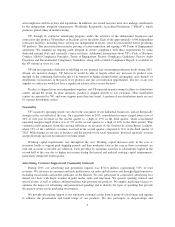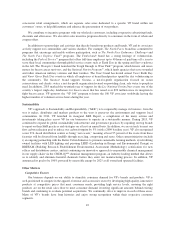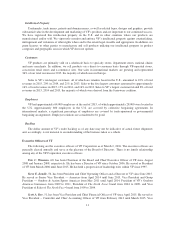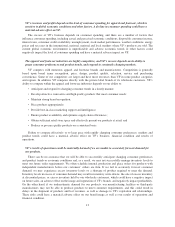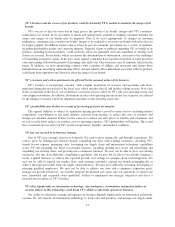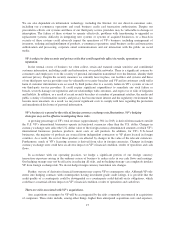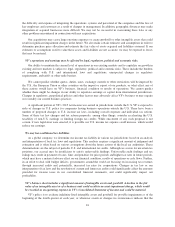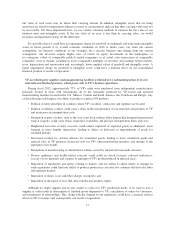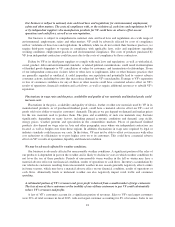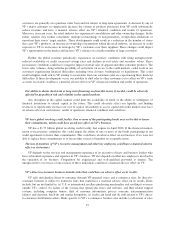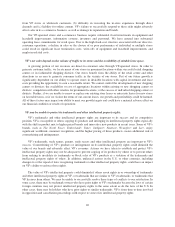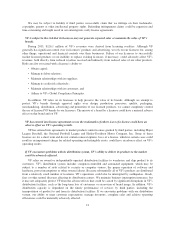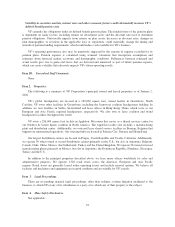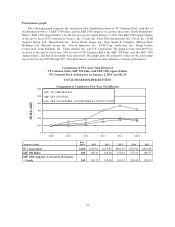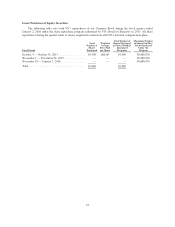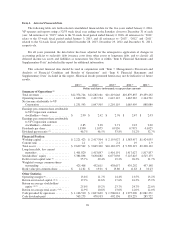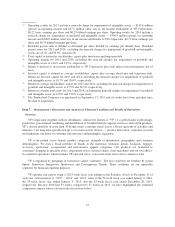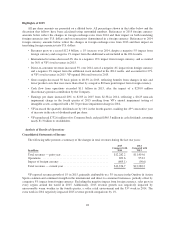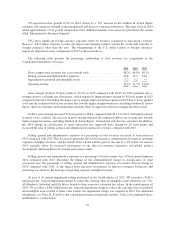North Face 2015 Annual Report Download - page 33
Download and view the complete annual report
Please find page 33 of the 2015 North Face annual report below. You can navigate through the pages in the report by either clicking on the pages listed below, or by using the keyword search tool below to find specific information within the annual report.customers are generally on a purchase order basis and not subject to long-term agreements. A decision by any of
VF’s major customers to significantly decrease the volume of products purchased from VF could substantially
reduce revenues and have a material adverse effect on VF’s financial condition and results of operations.
Moreover, in recent years, the retail industry has experienced consolidation and other ownership changes. In the
future, retailers may further consolidate, undergo restructurings or reorganizations, realign their affiliations or
reposition their stores’ target markets. These developments could result in a reduction in the number of stores
that carry VF’s products, an increase in ownership concentration within the retail industry, an increase in credit
exposure to VF or an increase in leverage by VF’s customers over their suppliers. These changes could impact
VF’s opportunities in the market and increase VF’s reliance on a smaller number of large customers.
Further, the global economy periodically experiences recessionary conditions with rising unemployment,
reduced availability of credit, increased savings rates and declines in real estate and securities values. These
recessionary conditions could have a negative impact on retail sales of apparel and other consumer products. The
lower sales volumes, along with the possibility of restrictions on access to the credit markets, could result in our
customers experiencing financial difficulties including store closures, bankruptcies or liquidations. This could
result in higher credit risk to VF relating to receivables from our customers who are experiencing these financial
difficulties. If these developments occur, our inability to shift sales to other customers or to collect on VF’s trade
accounts receivable could have a material adverse effect on VF’s financial condition and results of operations.
Our ability to obtain short-term or long-term financing on favorable terms, if needed, could be adversely
affected by geopolitical risk and volatility in the capital markets.
Any disruption in the capital markets could limit the availability of funds or the ability or willingness of
financial institutions to extend capital in the future. This could adversely affect our liquidity and funding
resources or significantly increase our cost of capital. An inability to access capital and credit markets may have
an adverse effect on our business, results of operations, financial condition and cash flows.
VF has a global revolving credit facility. One or more of the participating banks may not be able to honor
their commitments, which could have an adverse effect on VF’s business.
VF has a $1.75 billion global revolving credit facility that expires in April 2020. If the financial markets
return to recessionary conditions, this could impair the ability of one or more of the banks participating in our
credit agreements to honor their commitments. This could have an adverse effect on our business if we were not
able to replace those commitments or to locate other sources of liquidity on acceptable terms.
The loss of members of VF’s executive management and other key employees could have a material adverse
effect on its business.
VF depends on the services and management experience of its executive officers and business leaders who
have substantial experience and expertise in VF’s business. VF also depends on other key employees involved in
the operation of its business. Competition for experienced and well-qualified personnel is intense. The
unexpected loss of services of one or more of these individuals could have a material adverse effect on VF.
VF’s direct-to-consumer business includes risks that could have an adverse effect on its results.
VF sells merchandise direct-to-consumer through VF-operated stores and e-commerce sites. Its direct-to-
consumer business is subject to numerous risks that could have a material adverse effect on its results. Risks
include, but are not limited to, (a) U.S. or international resellers purchasing merchandise and reselling it overseas
outside VF’s control, (b) failure of the systems that operate the stores and websites, and their related support
systems, including computer viruses, theft of customer information, privacy concerns, telecommunication
failures and electronic break-ins and similar disruptions, (c) credit card fraud and (d) risks related to VF’s direct-
to-consumer distribution centers. Risks specific to VF’s e-commerce business also include (a) diversion of sales
19


